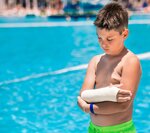Summer is the season of fun.
Warmer, longer days bring us together for pool parties, campfires, barbecues and road trips.
Children get a break from school, families take vacations, and more …
This item is available in full to subscribers.
To continue reading, you will need to either log in to your subscriber account, or purchase a new subscription.
If you are a digital subscriber with an active, online-only subscription then you already have an account here. Just reset your password if you've not yet logged in to your account on this new site.
Otherwise, click here to view your options for subscribing.
Please log in to continue |




Summer is the season of fun.
Warmer, longer days bring us together for pool parties, campfires, barbecues and road trips.
Children get a break from school, families take vacations, and more time is spent outdoors in the sun.
Unfortunately, however, summer is also the season of injury.
In June, July and August, more preventable injuries and deaths occur in the United States than at other times during the year.
Workplace injuries are also highest during these summer months, according to the U.S. Bureau of Labor Statistics.
As we enjoy the beginning of summer, let’s take a closer look at some of the most common forms of summertime injuries and how you can take steps to prevent them.
Motor Vehicle Accidents
Motor vehicle accidents are the third most common cause of preventable injury-related death in the U.S., responsible for 20% of all preventable deaths in 2022.
Car accidents happen all year, but they see an uptick in the summer months as more drivers take road trip vacations, road construction increases, and more people drive under the influence of alcohol.
Some motor vehicle accidents are unavoidable, but many can be prevented with responsible driving habits.
Wherever you are driving this summer — and all year — use these safe driving practices:
Fire and Fireworks Injuries
Campfires, barbecues and fireworks are summertime staples, but they are also hazards.
Burns are common summer injuries, especially around Independence Day and Labor Day when many celebrate with fireworks.
“Year after year, we see visits to our emergency department spike around the summer holidays,” says Dr. Maja Lundborg-Gray, Samaritan Emergency Medicine Physician.
“Many patients we treat around this time have preventable injuries like burns, fractures or other trauma caused by a mishap at a party or outdoor gathering.”
Unfortunately, Dr. Lundborg-Gray says, children are especially prone to this type of injury since they may not understand the risks associated with fires and fireworks.
Adults should never leave children unattended near an open flame and should be cautious about store-bought fireworks like sparklers, which can quickly ignite clothing or shoes.
Following these tips from the U.S. Fire Administration will further prevent burns this summer:
Bicycle, Skateboard and Related Accidents
Warmer weather and summer vacation mean more opportunities for families to ride together on bikes, scooters and skateboards.
As much fun as these activities are, they commonly cause injuries such as scrapes, fractures and concussions.
Accidents involving motor vehicles can cause more serious, life-threatening injuries.
Wearing a helmet is essential when riding a bike, skateboard or similar sports equipment.
The American College of Surgeons reports that helmets reduce the risk of head injury by 48%, traumatic brain injury by 53%, facial injury by 23%, and fatal injury by 34%.
Riders of all ages, including adults, should wear a properly-fitted helmet at all times. Knee and elbow pads are also recommended to protect joints during a fall or collision.
Swimming Injuries and Drowning
As summer progresses and temperatures rise, many people take to the water for swimming, boating and watersports.
Swimming is great exercise and a fun way to beat the heat, but it comes with its risks. Just like with fire-related injuries, accidents on the water frequently involve children.
The CDC reports drowning as a leading cause of death for children ages 14 and younger. Injuries from jumping into pools, boating accidents and slips and falls are also common over the summer months.
Parents can prevent swimming injuries by remaining vigilant while children are around the water.
Never leave your child alone near water; if you have to leave, take your child with you.
Enrolling your child in swim lessons is a good idea, but does not make it safe for them to swim alone.
Parents can also get training in CPR and First Aid to further protect their children and others. The CDC’s Top Ten Tips for Water Safety are recommended for all who plan to swim this summer:
When Accidents Happen, Samaritan is Here
Summer is an exciting time, and while it can be easy to get swept up in the fun and celebrations, it is important to take precautions to prevent injuries.
If accidents happen, Samaritan is here with 24/7 emergency care.
“Samaritan’s Emergency Department takes care of over 30,000 patients a year,” says Dr. Lundborg-Gray.
“We have specialty trained emergency medicine doctors, nurse practitioners, physician assistants and registered nurses ready at all hours.”
Learn more about Samaritan Medical Center’s Emergency Department, including tips on knowing when to call 911, at samaritanhealth.com/emergency-care